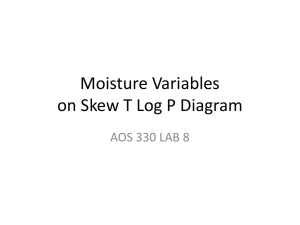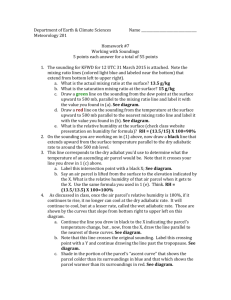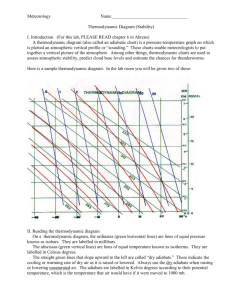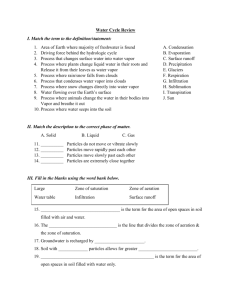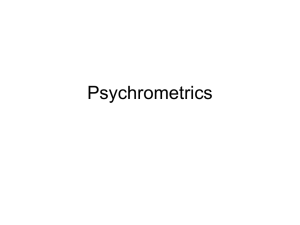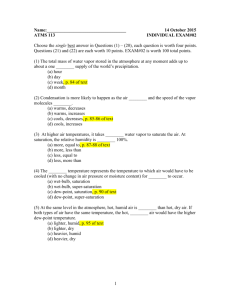Lab #5
advertisement
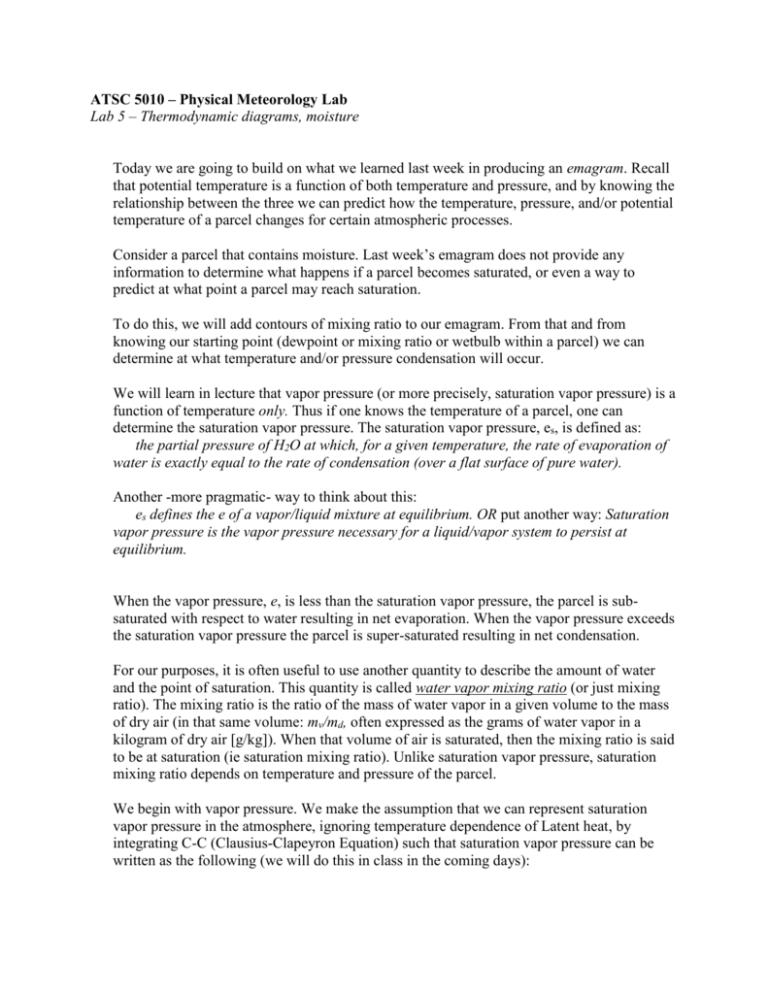
ATSC 5010 – Physical Meteorology Lab
Lab 5 – Thermodynamic diagrams, moisture
Today we are going to build on what we learned last week in producing an emagram. Recall
that potential temperature is a function of both temperature and pressure, and by knowing the
relationship between the three we can predict how the temperature, pressure, and/or potential
temperature of a parcel changes for certain atmospheric processes.
Consider a parcel that contains moisture. Last week’s emagram does not provide any
information to determine what happens if a parcel becomes saturated, or even a way to
predict at what point a parcel may reach saturation.
To do this, we will add contours of mixing ratio to our emagram. From that and from
knowing our starting point (dewpoint or mixing ratio or wetbulb within a parcel) we can
determine at what temperature and/or pressure condensation will occur.
We will learn in lecture that vapor pressure (or more precisely, saturation vapor pressure) is a
function of temperature only. Thus if one knows the temperature of a parcel, one can
determine the saturation vapor pressure. The saturation vapor pressure, es, is defined as:
the partial pressure of H2O at which, for a given temperature, the rate of evaporation of
water is exactly equal to the rate of condensation (over a flat surface of pure water).
Another -more pragmatic- way to think about this:
es defines the e of a vapor/liquid mixture at equilibrium. OR put another way: Saturation
vapor pressure is the vapor pressure necessary for a liquid/vapor system to persist at
equilibrium.
When the vapor pressure, e, is less than the saturation vapor pressure, the parcel is subsaturated with respect to water resulting in net evaporation. When the vapor pressure exceeds
the saturation vapor pressure the parcel is super-saturated resulting in net condensation.
For our purposes, it is often useful to use another quantity to describe the amount of water
and the point of saturation. This quantity is called water vapor mixing ratio (or just mixing
ratio). The mixing ratio is the ratio of the mass of water vapor in a given volume to the mass
of dry air (in that same volume: mv/md, often expressed as the grams of water vapor in a
kilogram of dry air [g/kg]). When that volume of air is saturated, then the mixing ratio is said
to be at saturation (ie saturation mixing ratio). Unlike saturation vapor pressure, saturation
mixing ratio depends on temperature and pressure of the parcel.
We begin with vapor pressure. We make the assumption that we can represent saturation
vapor pressure in the atmosphere, ignoring temperature dependence of Latent heat, by
integrating C-C (Clausius-Clapeyron Equation) such that saturation vapor pressure can be
written as the following (we will do this in class in the coming days):
𝑒𝑠 = 𝑒𝑠0 ∙ 𝑒𝑥𝑝 {(
𝐿𝑣𝑜 1 1
) ( − )}
𝑅𝑣 𝑇0 𝑇
Saturation mixing ratio can be related to pressure and saturation vapor pressure (and
therefore, T) by through the following:
𝑤𝑠 =
𝑅𝐷 𝑒𝑠
𝑅𝑣 𝑝 − 𝑒𝑠
In today’s lab, you will build an emagram similar to last week. You will also build a twodimensional array of saturation mixing ratio (similar to your array of potential temperature in lab
4), and use that to add an additional set of contours to your thermodynamic diagram.
Exercise:
The procedure you build today will be very similar to last week’s procedure (I recommend you
use last week’s as a starting point, note however that the limits have changed, and with IDL8.3
installed, you should be able to get the axes to work out properly…)
1. This week’s procedure will have the name “atsc5003_yourname_lab3”
2. Build a chart, similar to last week with the following characteristics:
Your chart background should be white, your axes and gridlines should be black
solid lines, and the chart size 500 pixels (in x) and 600 pixels (in y)
Temperature range from -30 to +40 C (label every 10 degrees, 0.1 C resolution)
Pressure range from 1050 mb to 250 mb (label every 100 mb, 1000 to 300, 1 mb
resolution)
Potential Temperature lines 250 to 460, label every other line, lines thick, solid
“Green”
Mixing Ratio lines (in g/kg): 0.5, 1, 2, 3, 4, 6, 8, 11, 15, 20, 30, 50, 75, 125, label
every line, solid “red”
Chart Title should read: “ATSC5003, Lab 3: ThermoDynamic Chart”
QUESTIONS:
First go through an answer the following questions by hand using your thermodynamic diagram.
Then check your answers by programming searches into your procedure (Use the WHERE
function and the MIN function, similar to lab 2)
1. Consider a parcel at 5 C and 750 mb. What is the parcel’s potential temperature? What is
the parcel’s saturation mixing ratio? From this information, can you determine the
parcel’s mixing ratio? Can you determine its dewpoint?
2. If the parcel in (1) is saturated, what is the parcel’s mixing ratio? What is its dewpoint?
3. Consider a parcel with a dewpoint of 0 C at 700 mb. What is the parcels mixing ratio?
4. Now lift the parcel in (3) to 400 mb (assuming it doesn’t saturate). What is the parcel’s
mixing ratio? What is the parcel’s dewpoint?
5. Now allow the parcel to descend to 1000 mb, what is the parcel’s mixing ratio?
Dewpoint?
6. Consider a parcel at 900 mb, with a temperature of 25 C and a dewpoint of 10 C. Raise
the parcel to the level of saturation (this is called the lifting condensation level, LCL).
What is the pressure at the LCL? What is the temperature of the parcel at the LCL? What
is the dewpoint? Is the mixing ratio at the LCL greater than, less than, or the same, as it
was at 900 mb (our starting point?).
Computing saturation mixing ratio array:
YOU CAN DO THIS using a FOR loop (easiest):
First, you will need to define saturation vapor pressure as a function of temperature…
Second, you need to define the size of the saturation mixing ratio array.
Lastly, loop over Pressure and compute saturation MR for all values of temperature at that
pressure:
Ws = DBLARR[number_of_pts_temperature, number_of_pts_pressure]
FOR i=0,number_of_pts_pressure
Ws[*,i] = yourfunction_satmixingratio( press[i],temperature[*] )
ENDFOR
OR you can do all of this with matrix_multiply and no loops (more tricky):
First, setup saturation vapor pressure array as above….
Then, you can create a 2D array for saturation vapor pressure using a matrix multiply by the
value 1. that has:
es[number-pts_temperature, number-pts_pressure]
(in this case es[i,*] all have the same value)
Finally, you can calculate directly with vector math the saturation mixing ratio array
Note: similar to over-plotting with the plot function; to draw additional contour lines, one must
use the overplot keyword in the CONTOUR function.
Problem 6:
You will likely need to utilize a DO loop. Best way to attack this problem: determine the MR
and SatMR, raise the parcel one pressure level, compare the MR to SatMR. If saturation is
reached, determine what your pressure and temperature is at that point, if saturation is not
reached raise the parcel another level and repeat….

